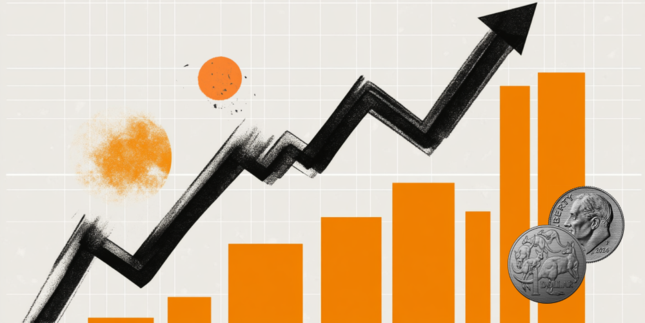- US Dollar stays strong against its major rivals to start the week.
- US Dollar Index clings to modest daily gains above 101.00.
- US data showed that private sector's economic activity continued to expand in July.
The US Dollar started the new week on a bullish note after having outperformed its major rivals in the previous week. The US Dollar Index, which tracks the USD's valuation against a basket of six major currencies, touched its highest level since July 12 near 101.50 in the early European session.
The USD captured capital outflows out of the Euro and Pound Sterling after the Services and Manufacturing PMI data from Germany, the EU and the UK came in weaker than expected for early July.
US S&P Global Manufacturing PMI improved to 49 in July's flash estimate from 46.3 in June. Services PMI edged lower to 52.4 from 54.4 in the same period. Finally, Composite PMI declined to 52 from 53.2, pointing to an ongoing expansion in the private sector's business activity, albeit at a softening pace.
The US Federal Reserve's two-day policy meeting will start on Tuesday and the interest rate decision will be announced on Wednesday.
Daily digest market movers: US Dollar gathers strength on Monday
- Commenting on PMI surveys' findings, "July is seeing an unwelcome combination of slower economic growth, weaker job creation, gloomier business confidence and sticky inflation," said Chris Williamson, Chief Business Economist at S&P Global Market Intelligence. "The overall rate of output growth, measured across manufacturing and services, is consistent with GDP expanding at an annualized quarterly rate of approximately 1.5% at the start of the third quarter," he added.
- 10-year US Treasury bond yield staged a rebound in the second half of last week and closed above 3.8% after having declined toward 3.7% earlier in the week. Following the PMI data, 10-year yield holds steady at around 3.8%.
- According to the CME Group FedWatch Tool, a 25-basis-point Fed rate hike on Wednesday is fully priced in. The probability of the Fed hiking the policy rate one more time before the end of the year stands at 23%.
- Assessing the USD's short-term outlook, "positioning data suggests investors are running reasonably large short Dollar positions into this week's Fed, ECB and BoJ policy meetings," noted economists at ING. "We do like a weaker USD later this year, but the Dollar's recent corrective rally might endure this week if the Fed hangs onto its tightening bias."
- Wall Street's main indexes opened mixed on Monday. After the opening bell, the Dow Jones Industrial Average was up 0.4% and the Nasdaq Composite was down 0.2%.
- German HOCB Composite PMI fell to 48.3 in Early July from 50.6 in June. Commenting on the data, “There is an increased probability that the economy will be in recession in the second half of the year," said Dr. Cyrus de la Rubia, Chief Economist at Hamburg Commercial Bank (HCOB).
- HCOB Composite PMI for the Eurozone worsened to 48.9 from 49.9 in the same period, while the UK S&P Global/CIPS Composite PMI fell to 50.7 from 52.8.
Technical analysis: US Dollar Index keeps the bullish bias
The US Dollar Index (DXY) started to edge higher after having tested 101.00 (static level) earlier in the day, confirming that level as important near-term support. Meanwhile, the Relative Strength Index (RSI) indicator on the daily chart extended its recovery toward 50, reflecting the lack of seller interest.
On the upside, the 20-day Simple Moving Average (SMA) aligns as dynamic resistance at 101.70 ahead of 102.00 (static level, former support). A daily close above the latter could bring in additional buyers and open the door for an extended uptrend toward 102.50/60 (50-day SMA, 100-day SMA).
In case the DXY returns below 101.00, 100.50 (static level) could be seen as the next support before 100.00 (psychological level, static level).
US Dollar FAQs
What is the US Dollar?
The US Dollar (USD) is the official currency of the United States of America, and the ‘de facto’ currency of a significant number of other countries where it is found in circulation alongside local notes. It is the most heavily traded currency in the world, accounting for over 88% of all global foreign exchange turnover, or an average of $6.6 trillion in transactions per day, according to data from 2022.
Following the second world war, the USD took over from the British Pound as the world’s reserve currency. For most of its history, the US Dollar was backed by Gold, until the Bretton Woods Agreement in 1971 when the Gold Standard went away.
How do the decisions of the Federal Reserve impact the US Dollar?
The most important single factor impacting on the value of the US Dollar is monetary policy, which is shaped by the Federal Reserve (Fed). The Fed has two mandates: to achieve price stability (control inflation) and foster full employment. Its primary tool to achieve these two goals is by adjusting interest rates.
When prices are rising too quickly and inflation is above the Fed’s 2% target, the Fed will raise rates, which helps the USD value. When inflation falls below 2% or the Unemployment Rate is too high, the Fed may lower interest rates, which weighs on the Greenback.
What is Quantitative Easing and how does it influence the US Dollar?
In extreme situations, the Federal Reserve can also print more Dollars and enact quantitative easing (QE). QE is the process by which the Fed substantially increases the flow of credit in a stuck financial system.
It is a non-standard policy measure used when credit has dried up because banks will not lend to each other (out of the fear of counterparty default). It is a last resort when simply lowering interest rates is unlikely to achieve the necessary result. It was the Fed’s weapon of choice to combat the credit crunch that occurred during the Great Financial Crisis in 2008. It involves the Fed printing more Dollars and using them to buy US government bonds predominantly from financial institutions. QE usually leads to a weaker US Dollar.
What is Quantitative Tightening and how does it influence the US Dollar?
Quantitative tightening (QT) is the reverse process whereby the Federal Reserve stops buying bonds from financial institutions and does not reinvest the principal from the bonds it holds maturing in new purchases. It is usually positive for the US Dollar.
Information on these pages contains forward-looking statements that involve risks and uncertainties. Markets and instruments profiled on this page are for informational purposes only and should not in any way come across as a recommendation to buy or sell in these assets. You should do your own thorough research before making any investment decisions. FXStreet does not in any way guarantee that this information is free from mistakes, errors, or material misstatements. It also does not guarantee that this information is of a timely nature. Investing in Open Markets involves a great deal of risk, including the loss of all or a portion of your investment, as well as emotional distress. All risks, losses and costs associated with investing, including total loss of principal, are your responsibility. The views and opinions expressed in this article are those of the authors and do not necessarily reflect the official policy or position of FXStreet nor its advertisers. The author will not be held responsible for information that is found at the end of links posted on this page.
If not otherwise explicitly mentioned in the body of the article, at the time of writing, the author has no position in any stock mentioned in this article and no business relationship with any company mentioned. The author has not received compensation for writing this article, other than from FXStreet.
FXStreet and the author do not provide personalized recommendations. The author makes no representations as to the accuracy, completeness, or suitability of this information. FXStreet and the author will not be liable for any errors, omissions or any losses, injuries or damages arising from this information and its display or use. Errors and omissions excepted.
The author and FXStreet are not registered investment advisors and nothing in this article is intended to be investment advice.
Recommended content
Editors’ Picks

AUD/USD holds lower ground below 0.6300 despite renewed China optimism
AUD/USD stays depressed below the 0.6300 mark in the Asian session on Thursday amid uncertainty over US President Donald Trump's tariff plans. The Aussie shrugs off a risk-rally in Chinese stocks on fresh support measures as the US Dollar holds ground ahead of top-tier US data releases.

USD/JPY bounces to near 155.50 amid modest US Dollar uptick
USD/JPY finds fresh buyers and bounces to near 155.50 in the Asian session on Thursday. The pair reverses an early dip-=led by the better-than-expected Japanese Trade Balance data. Further upside could be capped amid prospects for an imminent BoJ rate hike on Friday.

Gold buyers pause but refuse to give up yet
Gold price consolidates its three-day bullish momentum early Thursday, having reached three-month highs of $2,763 on Wednesday. Gold buyers take a breather as attention turns toward US fundamentals, with the weekly Jobless Claims on tap.

Ripple's XRP ETFs: Is SEC approval on the horizon following CME's rumored futures launch?
The Chicago Mercantile Exchange allegedly plans to launch Ripple's XRP and Solana futures contracts following a now-deleted post on a staging website detailing how trading for both assets will function.

Netflix posts record quarter, as Trump talks tariffs on China
There has been a positive tone to risk this week, as the market digests Trump 2.0. However, Trump is not the only show in town. Earnings reports are also a key driver of stock indices, and the news is good.

Trusted Broker Reviews for Smarter Trading
VERIFIED Discover in-depth reviews of reliable brokers. Compare features like spreads, leverage, and platforms. Find the perfect fit for your trading style, from CFDs to Forex pairs like EUR/USD and Gold.